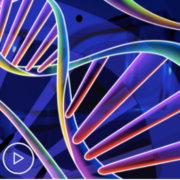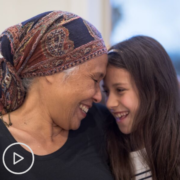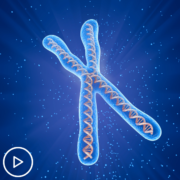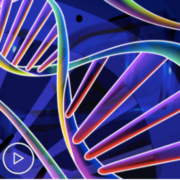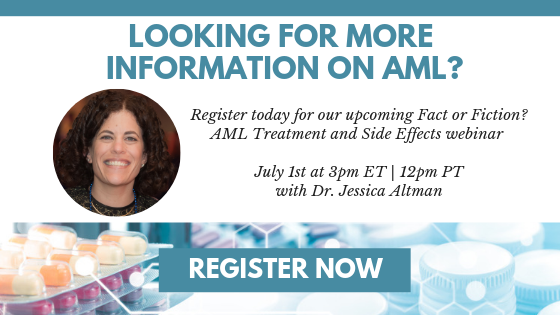What is Leukemia?
As with many other cancers, leukemia is not a singular disease. There are many types of leukemia, and while it is a common childhood cancer, leukemia actually occurs more often in older adults. Leukemia is the most common cancer in people under the age of 15, but it is most likely to affect people who are 55 or older. There are more than 60,000 cases of adult leukemia diagnosed each year, and it is more common among men than women.
Leukemia is a broad term that describes cancer of the blood or bone marrow. It starts when the DNA of developing blood cells are damaged and the bone marrow makes abnormal cells. The abnormal blood cells are the leukemia cells which grow and divide uncontrollably. Unlike healthy cells that follow a life cycle, the leukemia cells don’t die when they are supposed to so they continue to build up, eventually overcrowding the blood. They crowd out normal white blood cells, red blood cells, and platelets so those normal cells can’t grow and function. Eventually, there are more cancer cells than healthy cells in the blood. The type of leukemia is determined based on which blood cells are affected by the abnormal cells. Leukemia usually affects the white blood cells, called leukocytes, but can occur in other blood cells. There are four main types of leukemia: chronic, acute, lymphocytic, and myelogenous.
Leukemia that grows slowly is called chronic leukemia. The cancer cells form very slowly so the body can also continue to form healthy cells, but over time the cancer cells continue to grow and the leukemia worsens.
Acute leukemia grows very quickly and gets worse really fast. It has been identified as the most rapidly progressing cancer, and it can develop and grow in a matter of days or weeks.
Lymphocytic leukemia forms in the part of the bone marrow that makes lymphocytes, which are white blood cells that are also immune cells. Chronic lymphocytic leukemia (CLL) is most common in older adults and makes up about 25 percent of adult leukemia cases. It is more common in men than women and is very rare in children. Acute lymphoblastic leukemia (ALL) also affects older adults, but children younger than five have the highest risk of developing it.
Myelogenous leukemia forms in the bone marrow cells that produce blood cells, rather than forming in the actual blood cells. Chronic myelogenous leukemia (CML) accounts for about 15 percent of all leukemia cases in the United States. CML develops mostly in adults and is very rare in children. Acute myelogenous leukemia (AML) is a rare cancer that develops quickly with symptoms of fever, difficulty breathing, and pain in the joints. It can be caused by environmental factors, and develops more often in adults than children, and more often in men than women.
There are also several less common types of leukemia. Most of these types are chronic, and each year in the United States, about 6,000 cases of these less common leukemias are diagnosed.
- Chronic myelomonocytic leukemia (CMML) develops from myeloid cells.
- Juvenile myelomonocytic leukemia (JMML) is typically found in very young children and is another type of myeloid leukemia.
- Acute promyelocytic leukemia (APL) is a subtype of AML.
- Hairy cell leukemia is slow growing, chronic, and makes too many B cells that appear hairy wen viewed under a microscope.
Leukemia Possible Risk Factors
There are several risk factors linked to leukemia. There are environmental factors and genetic reasons why some people might develop leukemia. Some of the factors can be controlled while others can not. Age, smoking history, and exposure to hazardous chemicals are all possible risk factors. Other risk factors may include exposure to chemicals or medical treatments, personal health history, and family history. Some of the possible risk factors need more study to determine a definite link to leukemia, but being aware of your potential risk is important.
If you were exposed to chemotherapy or radiation therapy for another cancer you have a higher chance of getting leukemia later in life. Also, children who took medications to suppress their immune systems, such as after an organ transplant, may develop leukemia. Exposure to chemicals such as benzene and formaldehyde, often found in cleaning products, hair dyes, and embalming fluid, may also increase your risk of developing leukemia. Smoking and exposure to workplace chemicals like gasoline, diesel and pesticides could also be a risk factor.
There are several syndromes, conditions, and genetic disorders that can also increase leukemia risk. Li-Fraumeni syndrome, a hereditary disorder, is linked to leukemia, and children with Down syndrome have a two to three percent increased risk of developing acute myeloid or acute lymphocytic leukemia. Other genetic disorders that increase leukemia risk are Fanconi anemia, and dyskeratosis congenita (DKC). The inherited immune system conditions ataxia-telangiectasia, Bloom syndrome, Schwachmai-Diamond syndrome, and Wiskott-Aldrich syndrome also increase the risk of leukemia. Risk is also increased in patients with a history of blood disorders such as myelodysplastic syndrome, myeloproliferative neoplasm, and aplastic anemia. There are also viruses, such as the human T-lymphotropic virus (HTLV-1), linked to leukemia.
Family history can also play a role in the development of leukemia. Having a sibling with leukemia is a risk factor, and having an identical twin with leukemia gives you a one in five chance of developing it yourself.
Preventing Leukemia
There are no known ways to prevent leukemia; however, being aware of risk factors and attempting to reduce them could help. Studies have linked leukemia to smoking and obesity, so quitting smoking and having a healthy body weight could help prevent leukemia. In addition, avoiding heavy exposure to dangerous chemicals might decrease your risk.
Signs and Symptoms
There are no reliable early screening methods for leukemia and, especially in chronic leukemia, the symptoms may not be very noticeable early on. Symptoms such as fatigue and fever may not be alarming at first, and could be mistakenly attributed to other causes. Acute leukemia symptoms come on faster and are typically more noticeable. All types of leukemia can have similar symptoms, but the symptoms each individual patient has can help determine the type of leukemia. Any symptoms should be checked by a doctor.
The most common symptoms of leukemia are:
- Extreme fatigue that doesn’t respond to a good night sleep
- Enlarged lymph nodes that are swollen and tender as a result of leukemia cells building up
- Unexplained fever higher than 101 degrees that occurs frequently or lasts more than three weeks with no explanation
- Night sweats that can also occur during the day, and can drench the sheets through to the mattress
- Bruising and excess bleeding such as frequent nose bleeds caused by poor blood clotting which is also a symptom
- Poor blood clotting is apparent when small red or purple spots, called petechiae, appear
- Abdominal pain occurs when white blood cells accumulate in the liver or spleen
- Bone and joint pain usually occurs in the hips or sternum where there is a lot of bone marrow that is being crowded by abnormal cells
- Headaches and other neurological symptoms such as seizures, dizziness, visual changes, nausea, vomiting can occur due to leukemia cells in the fluid around the brain and spinal cord
- Unintentional weight loss of five percent or more of your body weight in 12 months or less. Weight loss can sometimes be a result of having a swollen liver or spleen which can lead to loss of appetite
- Frequent infections occur because white blood cells aren’t working properly to fight infections
- Anemia, or iron deficiency, occurs when there is a lack of hemoglobin in the blood to transport iron in the body. Iron deficiency can cause labored breathing and pale skin. Symptoms of anemia are nausea, fever, chills, night sweats, flu-like symptoms, weight loss, bone pain, and tiredness
Complications from Leukemia
Leukemia can cause several serious complications due to the nature of the disease and treatment. Complications such as life-threatening infections can occur when white blood cells are damaged or reduced. When white blood cells aren’t fully functioning, the body can’t properly fight infections, so any infections a leukemia patient gets, such as urinary tract infections or pneumonia, can become very serious. Low platelet counts make bleeding in areas such as the brain, the lungs, and the stomach or intestines very dangerous, while high white blood cell counts can cause leukemia cells to spill over from the blood into other organs possibly causing respiratory failure, stroke, or heart attack.
There are other complications that are related to specific types of leukemia. Notably, the development of secondary cancers and blood cancers are more likely in CLL patients. Another complication of CLL is called a Richter transformation in which the cells can transform into an aggressive form of lymphoma. Kidney failure can be a treatment-related complication of AML or ALL.
Leukemia Diagnosis
Leukemia can’t be diagnosed based solely on symptoms, but if leukemia is suspected, in a general exam, the doctor will look for an enlarged spleen or liver and take a blood sample. Further diagnostic testing may include a bone marrow test where a long needle is used to extract marrow from the center of a bone (usually the hip). The bone marrow test will help determine if the patient has leukemia and the type of leukemia.
Staging Leukemia
Staging is used to identify the size and location of cancer in the body. Typically cancers have four stages with Stage I usually indicating the cancer is in one location and is not very large. Stage IV indicates the cancer has grown large and spread far from the original location. Most leukemias aren’t usually staged because they are in the blood and therefore have already spread throughout the body. Instead, leukemia can be considered untreated, active, in remission, or recurrent. The exception is CLL, which can spread through the lymph nodes or the blood or bone marrow, so it does have three stages.
Treatment
The earlier treatment starts for leukemia, the better chance of remission. However, thanks to some exceptional advancements in leukemia treatment medications, doctors are often able to take the time they need to come up with the best treatment plan for each individual with leukemia, even in cases of acute leukemia if life-threatening complications are not present. When coming up with a treatment plan, doctors consider the patient’s age, overall health, and most importantly, the type of leukemia the patient has.
Leukemia treatment options vary for each type of cancer:
Watchful Waiting is used when treatment for slower growing leukemias, such as CLL, may not be necessary;
Chemotherapy is the primary treatment for AML, and sometimes a bone marrow transplant is needed;
Targeted therapies are medications that are tyrosine kinase inhibitors which target cancer cells, but don’t affect healthy cells. Targeted therapies have less side effects. Many CML patients have a gene mutation that responds very well to targeted therapy;
Interferon therapy is a drug that acts similar to a naturally occurring immune response which slows and then stops the leukemia cells. This therapy can cause severe side effects;
Radiation therapy is often used in ALL to kill bone marrow tissue before a transplant is done;
Surgery to remove the spleen may be necessary, depending on the type of leukemia;
Stem cell transplant is effective in treating CML and is usually more successful in younger patients. After chemotherapy or radiation or both are used to destroy the bone marrow, new stem cells are implanted into the bone marrow so noncancerous cells can grow.
Treatment for acute leukemia can take up to two years. It is usually done in phases. In the first phase the goal is to use chemotherapy for several weeks to kill the cancer cells and put the patient in remission. The second phase is designed to kill any remaining cancer cells using chemotherapy or stem cell transplant or both. The treatments and their side effects can be pretty harsh for older patients so researchers have been focusing on finding targeted therapies for acute leukemia, which have fewer side effects. Researchers are also hoping CAR T-cell therapy, which uses the patient’s own immune system to treat cancer, could be an eventual replacement for stem cell replacement therapy in older ALL patients. AML is more aggressive and often harder to treat, but several new targeted medications have been approved to treat AML. Researchers continue to look at other targeted therapy options and other drugs for AML.
In some cases of chronic leukemia, a stem cell transplant might be required, but the main treatment is oral medications that patients will probably take for the rest of their lives. Some research is investigating whether or not patients could potentially stop taking the medications at a certain point.
CML treatments have really advanced and there are now several drugs that target the abnormal protein that causes CML. Thanks to these targeted medications CML patients now have a close to normal life expectancy and a 90 percent five-year survival rate. Clinical trials are looking at using targeted therapies to treat CLL as well and CAR T-cell therapies are also being considered for CLL treatment.
Recovery and Survival
Leukemia represents 3.5 percent of all new cancer cases in the United States, and it is the seventh leading cause of cancer death. The outlook for leukemia patients depends on which type of leukemia they have, their overall health, and their age. Leukemia is more likely to be fatal in older patients. The average age of those who die from leukemia is 75. However, the many advances in treatment options and medications, such as targeted therapies, have created a better prognosis for many. Leukemia has a 62.7 percent five-year survival rate, and some people with leukemia can now achieve complete remission.
Sources
Felman, Adam. “What to Know About Leukemia” Medical News Today, medically reviewed August 28, 2019, https://www.medicalnewstoday.com/articles/142595. Accessed March 9, 2020.
Raymaakers, Karen. “Symptoms of Leukemia” Verywell Health, medically reviewed November 1, 2019, https://www.verywellhealth.com/leukemia-signs-and-symptoms-2252435. Accessed March 9, 2020.
“Adult Leukemia: What You Need to Know” Dana-Farber Cancer Institute, updated December 5, 2019, https://blog.dana-farber.org/insight/2019/11/adult-leukemia-five-things-you-need-to-know/. Accessed March 9, 2020.
Wang, Eunice. “How Fast Does Leukemia Develop” Roswell Park Comprehensive Cancer Center, October 4, 2018, https://www.roswellpark.org/cancertalk/201810/how-fast-does-leukemia-develop. Accessed March 9, 2020.
“Reducing Your Risk for Leukemia” Canadian Cancer Society, https://www.cancer.ca/en/cancer-information/cancer-type/leukemia/risks/reducing-your-risk/?region=on. Accessed March 9, 2020.
“Risk Factors for Leukemia” Canadian Cancer Society, https://www.cancer.ca/en/cancer-information/cancer-type/leukemia/risks/?region=on. Accessed March 9, 2020.
Stöppler, Melissa Conrad. “Leukemia” MedicineNet, medically reviewed September 11, 2019, https://www.medicinenet.com/leukemia/article.htm. Accessed March 9, 2020.
“Leukemia Screening” Moffitt Cancer Center, https://moffitt.org/cancers/leukemia/diagnosis/screening/. Accessed March 9, 2020.
“Leukemia — Patient Version” National Cancer Institute, https://www.cancer.gov/types/leukemia. Accessed March 9, 2020.
“Cancer Stat Facts — Leukemia” National Cancer Institute Surveillance, Epidemiology, and End Results Program, https://seer.cancer.gov/statfacts/html/leuks.html. Accessed March 9, 2020.
“Advances in Leukemia Research” National Cancer Institute, June 25, 2019,https://www.cancer.gov/types/leukemia/research. Accessed March 9, 2020.






